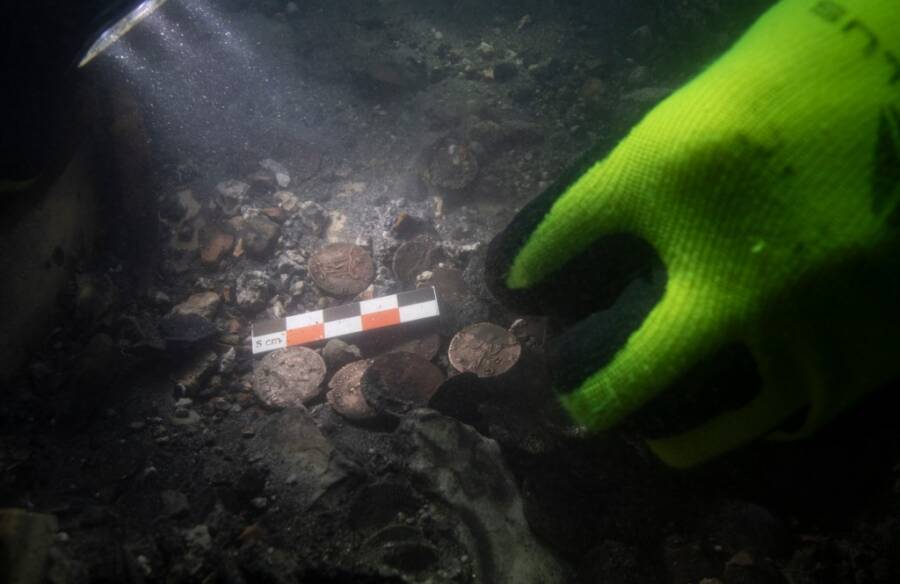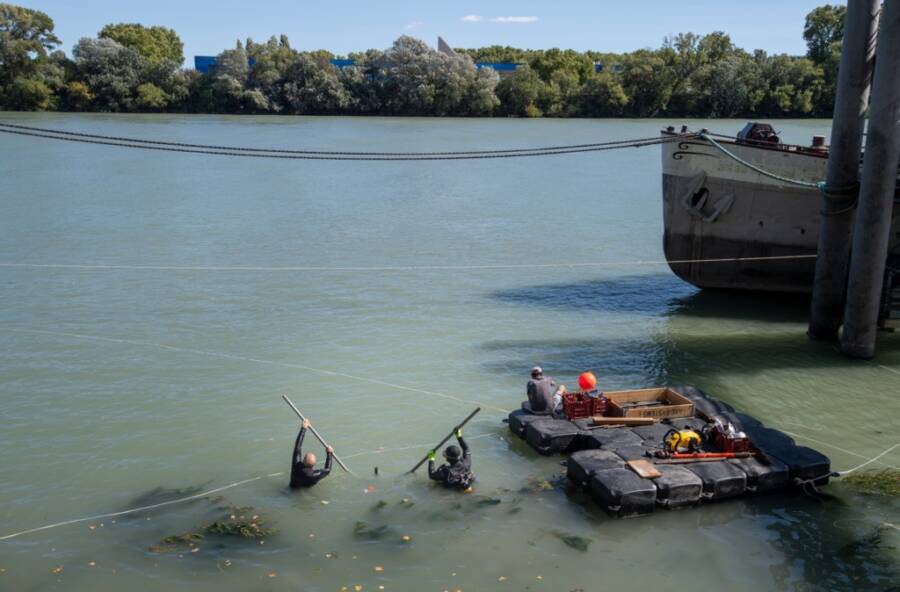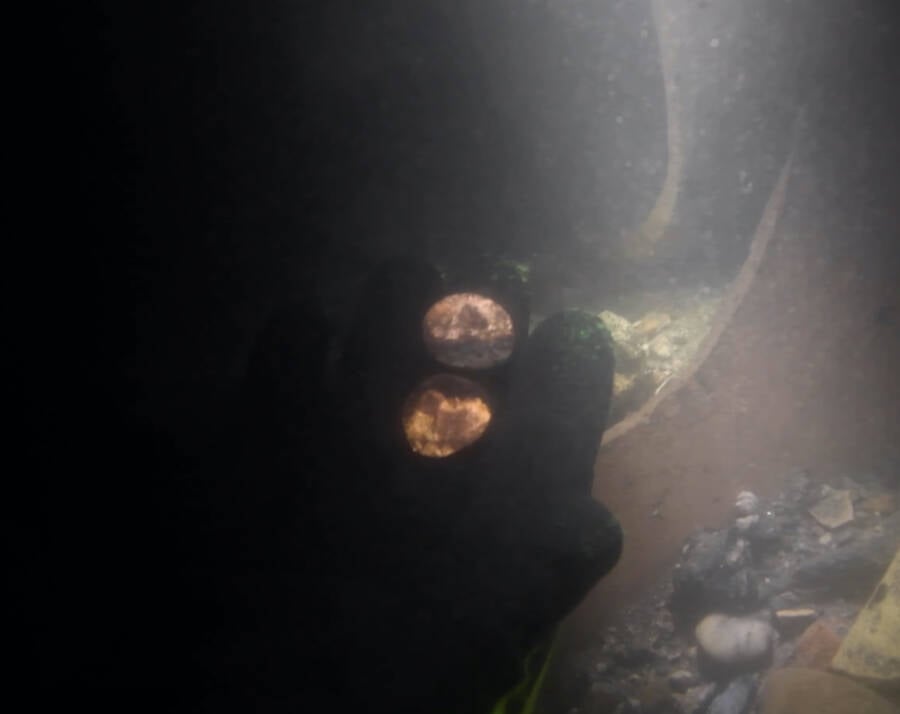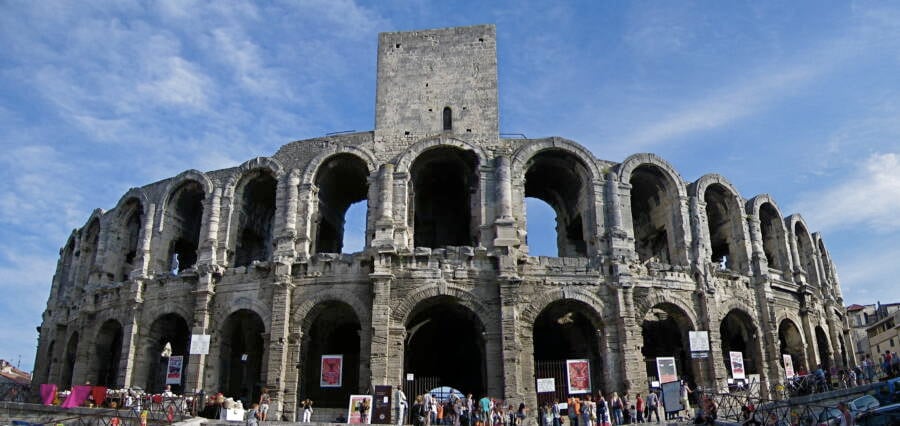Though the coins were discovered along with the remains of a 65-foot-long ancient ship, researchers aren't sure if the two finds are connected and don't know exactly how this Roman treasure trove ended up at the bottom of the Rhône.

Lionel ROUX_CCJ-(CNRS-AMU)These coins are just the latest discovery from the days of ancient Rome that archaeologists have made in the Rhône River.
The French city of Arles has long been famous for its Roman history and well-preserved ancient ruins. Still, it came as a thrilling discovery for archaeologists when they uncovered more than 800 Roman-era coins in the Rhône River.
The coins are just the latest incredible discovery to emerge from the river’s murk. But archaeologists have many remaining questions about their provenance, and are even hoping to find the “treasure chest” that once held them.
“The Miracle Of The Arlesian Rhône”: A Trove Of Roman Discoveries

Lionel ROUX_CCJ-(CNRS-AMU)Underwater archaeologists found the coins bit by bit, eventually collecting 847 coins that mostly date to the third century C.E.
According to a press release from the city of Arles, the discovery of the coins followed a series of other exciting archaeological finds in the Rhône River. In previous years, archaeologists had uncovered an ancient barge, a life-size marble bust of a man believed to be Julius Caesar, and another batch of coins.
During their most recent expedition, which began in August and lasted until early October 2025, archaeologists found this newest trove of coins little by little. First, divers came across 60 coins, then 80, and then the final motherlode of 600. In all, divers collected 847 coins, including a sestertius of Roman emperor Trajan (98 to 117 C.E.) that dates back to 116 C.E.
“We talk about the miracle of Pompeii, but there’s also the miracle of the Arlesian Rhône,” said underwater archaeologist David Djaoui. “Despite difficult conditions, with currents and poor visibility, the research was fruitful. In particular, we found the membrane of a boat about twenty meters long and therefore these pieces, most of which date from the 3rd century, some of which are in very good condition.”
So how did the coins end up at the bottom of the Rhône?

Lionel ROUX_CCJ-(CNRS-AMU)More than 800 coins were found in all, with the largest single batch consisting of approximately 600.
Djaoui suspects it was some kind of accident. He believes that the coins were also once held in a “treasure chest like the ones we see in the movies,” which archaeologists still hope to find.
The Rich Roman History Of Arles
By the time the coins sank in the Rhône River roughly 1,800 years ago, Arles had been a Roman city for centuries. The Romans first conquered the city, which they called Arelate, in 123 B.C.E., and it swiftly became a thriving economic hub. Then closer to the ocean than it is today, Arles was a port city, and its location along a major trade route between Italy and Spain gave it strategic importance to the rapidly growing Roman Empire.
As such, the Romans filled the city with stunning monuments including an amphitheater (known as the Arènes) that could seat 2,000 spectators, another theatre, baths, and a sprawling necropolis. Many of these Roman structures still stand today, and Arles is renowned around the world for its wealth of ancient ruins.

Public DomainArles’ famous Roman amphitheatre, one of its many stunning ancient ruins.
After the fall of the Roman Empire in the fifth century C.E., Arles continued to be politically important, though it was ultimately overshadowed by its neighbor, Marseille.
Today, the city is perhaps best known for both its Roman ruins and its association with Vincent van Gogh, who spent a year in the city and produced hundreds of paintings that captured Arles’ unique color and light.
But clearly, Arles still has more story to tell. The discovery of the coins in the Rhône stands as a potent reminder of the city’s rich and ancient history. And though visitors and locals alike can enjoy Arles’ many stunning Roman ruins on the city’s streets, the Rhône River has proven again and again in recent years that there are further discoveries to be made beneath the surface.
Djaoui, who is still hoping to find the coins’ treasure chest, is certain that archaeologists will be making new discoveries in the river for years to come: “The Arlesian waters of the Rhône will continue to offer exceptional discoveries for hundreds, even thousands of years.”
After reading about the hundreds of Roman coins that were found in the depths of the Rhône River in Arles, France, go inside the surprisingly complicated question of when the Roman Empire fell. Then, discover the true story of the Roman emperor Caligula, the ruler who allegedly tried to make his horse a senator.





